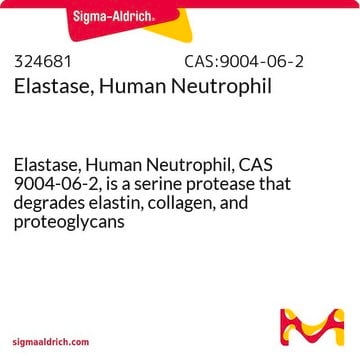219373
Cathepsin G, Human Neutrophil
Cathepsin G, Human Neutrophil, CAS 107200-92-0, is a purified native cathepsin G. Acts as a potent agonist of human platelet activation leading to their aggregation.
Synonim(y):
Cathepsin G, Human Neutrophil
About This Item
Polecane produkty
pochodzenie biologiczne
human neutrophils
Poziom jakości
Próba
≥95% (SDS-PAGE)
Postać
lyophilized solid (Salt-free)
aktywność właściwa
≥2 units/mg protein
producent / nazwa handlowa
Calbiochem®
warunki przechowywania
OK to freeze
metody
inhibition assay: suitable
przydatność
suitable for molecular biology
Zastosowanie
life science and biopharma
Warunki transportu
ambient
temp. przechowywania
−20°C
informacje o genach
human ... CTSG(1511)
Opis ogólny
Cathepsin G is stored in its active form in azurophil granules of neutrophils or monocytes. Its mature form contains one potential glycan-binding site and three disulfide bonds.
Zastosowanie
Działania biochem./fizjol.
Ostrzeżenie
Definicja jednostki
Uwaga dotycząca przygotowania
Reconstitute in 150 mM NaCl, 50 mM sodium acetate buffer, pH 5.5.
Rekonstytucja
Inne uwagi
Shamamian, P., et al. 2001. J. Cell Physiol.189, 197.
Groutas, W.C., et al. 1993. Biochem. Biophys. Res. Commun.197, 730.
Stone, P.J., et al. 1993. Biochem. Biophys. Res. Commun.197, 130.
Groutas, W.C., et al. 1992. Arch. Biochem. Biophys.294, 144.
Maison, C.M., et al. 1991. J. Immunol.147, 921.
Travis, J. 1988. Am. J. Med.84, 37.
Informacje prawne
Kod klasy składowania
11 - Combustible Solids
Klasa zagrożenia wodnego (WGK)
WGK 3
Temperatura zapłonu (°F)
Not applicable
Temperatura zapłonu (°C)
Not applicable
Certyfikaty analizy (CoA)
Poszukaj Certyfikaty analizy (CoA), wpisując numer partii/serii produktów. Numery serii i partii można znaleźć na etykiecie produktu po słowach „seria” lub „partia”.
Masz już ten produkt?
Dokumenty związane z niedawno zakupionymi produktami zostały zamieszczone w Bibliotece dokumentów.
Nasz zespół naukowców ma doświadczenie we wszystkich obszarach badań, w tym w naukach przyrodniczych, materiałoznawstwie, syntezie chemicznej, chromatografii, analityce i wielu innych dziedzinach.
Skontaktuj się z zespołem ds. pomocy technicznej






